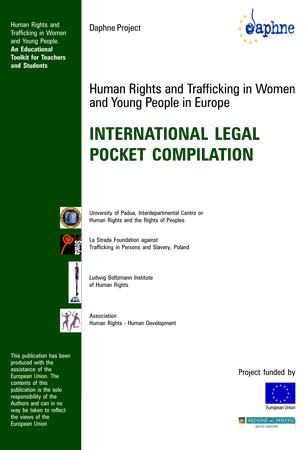Raccolte

Human Rights and Trafficking in Women and Young People in Europe - International Legal Pocket Compilation
- Tipologia pubblicazione
- Altre pubblicazioni
- Pagine
- 105
- Lingua
- EN
Introduction
The aim of this International Legal Pocket Compilation is to provide teachers with a basic yet complete educational Toolkit containing the main international and regional laws on the dramatic theme of trafficking in human beings and its
manifold implications under the human rights perspective, with particular
reference to women and young people’s condition involved in sexual
exploitation.
The material selected herein takes into account both the need –however
unfeasible – for the most comprehensive information possible - and didactic
motivations.
Trafficking in human beings and the manifold implications this phenomenon
generates from a human rights point of view, has given rise to a rich
documentation on the issue which are presented herein as articles and excerpts.
All the acts listed in this Compilation include basic reference elements and a
brief introductory note that should help teachers transmit awareness to students and diffuse knowledge on human rights, which in its very nature is transversal to single disciplines.
In identifying the material and in its thematic development the model adopted
was that of the United Nations classification, especially from the Office of the
United Nations High Commissioner on Human Rights.
Issues on trafficking in human beings must depart from a legal basis rooted in
juridical instruments of universal breadth that is provided by the "International
Bill of Human Rights", especially the 1948 Universal Declaration on Human
Rights and the two Covenants on the economic, social and cultural rights and oncivil and political rights of 1966.
The rest of the International Legal Pocket Compilation is organized in thematic
categories which trace both binding norms (conventions, treaties, protocols…),
and recommendations (declarations, resolutions, principles, guidelines, etc.)
that, depending on the category, can prove pertinent. [...]

